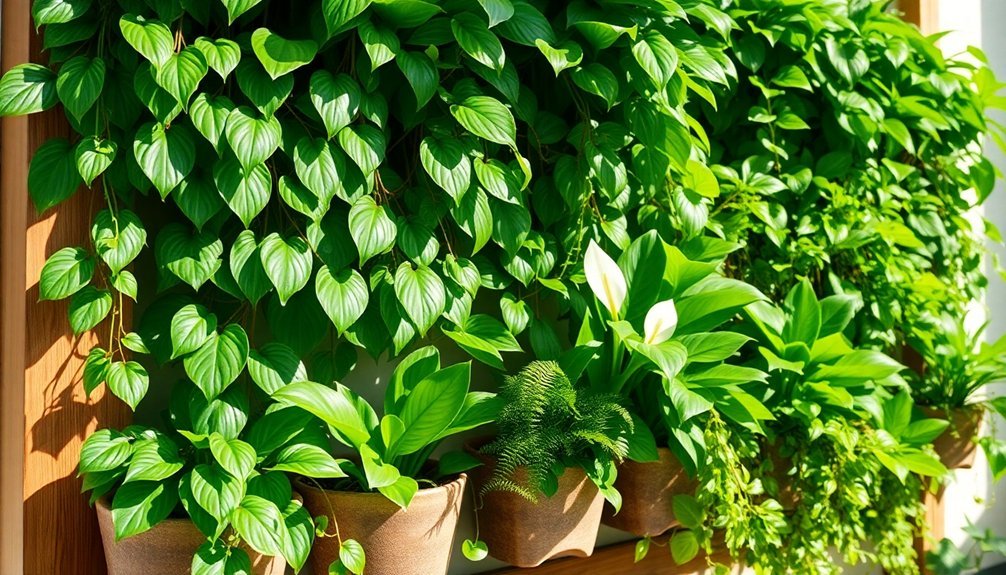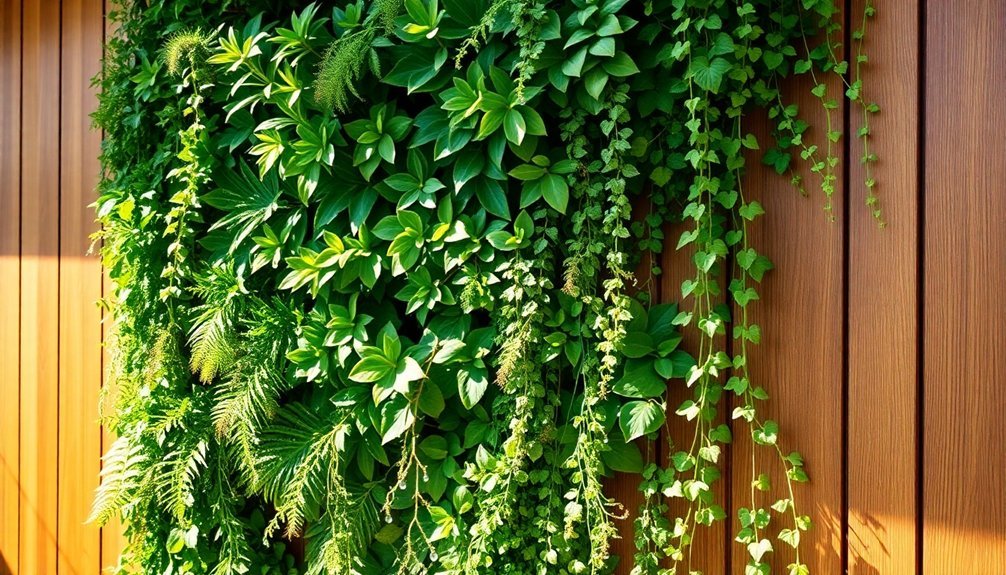Transform your indoor air quality with three proven vertical garden tricks. First, layer oxygen-powerhouses like snake plants and peace lilies to maximize CO2 conversion. Next, create a modular system with climbing plants on trellises to enhance air circulation throughout your space. Finally, position taller plants at the back and shorter ones at eye level for ideal air flow. These fundamentals will set you up for a fresher, healthier living environment.
Selecting Air-Purifying Plants for Vertical Spaces

When creating a vertical garden that doubles as an air purifier, selecting the right plants can transform your living space into a healthier environment.
Your DIY vertical garden should include snake plants, which uniquely convert CO2 to oxygen at night, making them perfect for bedroom installations.
You'll want to add peace lilies to combat formaldehyde and benzene in lower light areas of your vertical space.
Spider plants are versatile air-quality champions that'll thrive almost anywhere while absorbing carbon monoxide.
Don't forget pothos – they're excellent at filtering xylene and toluene while adapting beautifully to vertical growing conditions.
Plants need specific conditions to thrive in your indoor garden, so consider moisture-loving options like Boston ferns, which effectively remove air pollutants when provided with consistent watering in your vertical setup.
Maximizing Oxygen Production in Limited Areas
Although space may be limited in urban environments, you can maximize oxygen production in your vertical garden through strategic plant selection and placement. Your living walls can produce enough oxygen for one person per square meter when you choose high-performing plants like ferns and succulents.
To optimize your indoor vertical garden's oxygen output, install modular systems that guarantee maximizing exposure to sunlight and proper air circulation.
You'll want to incorporate diverse plant species, which not only enhances biodiversity but also contributes to better fresh air quality.
Don't forget that regular maintenance is essential – keep your plants healthy through consistent pruning, adequate watering, and proper light management.
Strategic Plant Placement for Enhanced Air Flow

Building on the principles of oxygen production, strategic plant placement plays a key role in maximizing your vertical garden's air circulation. You'll want to position taller plants at the back and arrange air-purifying plants at eye level for ideal filtration. Group species with similar light needs together, and install trellises to support climbing varieties while maintaining proper airflow.
| Plant Position | Airflow Benefits |
|---|---|
| Back Layer | Unobstructed air movement |
| Middle Layer | Humidity reduction |
| Eye Level | Maximum air filtration |
| Climbing Area | Enhanced circulation |
| Bottom Layer | Complete air flow path |
Regular maintenance is essential for vertical gardening success. Keep your garden thriving by pruning overgrowth and ensuring plants don't become too dense. This strategic approach to plant placement will create a well-ventilated, healthy environment that maximizes your garden's air-purifying potential.
Frequently Asked Questions
Are There Any Drawbacks to Using Vertical Gardens?
You'll face higher maintenance needs, increased watering demands, and bigger setup costs with vertical gardens. They're also limited in plant choices, can have structural issues, and are more vulnerable to weather damage.
How Often Should You Water a Vertical Garden?
You'll need to water your vertical garden every 2-7 days, depending on your climate and plants. Check soil moisture weekly by inserting your finger an inch deep—if it's dry, it's time to water.
What Are the Techniques of Vertical Gardening?
You'll need trellises, wall pockets, or modular systems to support plants. Choose lightweight soil, install drip irrigation, train climbing plants regularly, and mix different plant varieties for the best vertical gardening results.
How Do Vertical Gardens Help Climate Change?
You'll see vertical gardens combat climate change by absorbing CO2, reducing urban heat, conserving energy, managing stormwater runoff, and filtering air pollutants. They're also great for supporting biodiversity in urban environments.
In Summary
Your vertical garden can transform any indoor space into a natural air purification system. You'll breathe easier when you've selected the right oxygen-producing plants, positioned them strategically for maximum airflow, and optimized your limited vertical space. Don't forget to maintain proper spacing between plants and rotate them occasionally for even growth. Now you're ready to enjoy fresher, cleaner air in your living space.





Leave a Reply